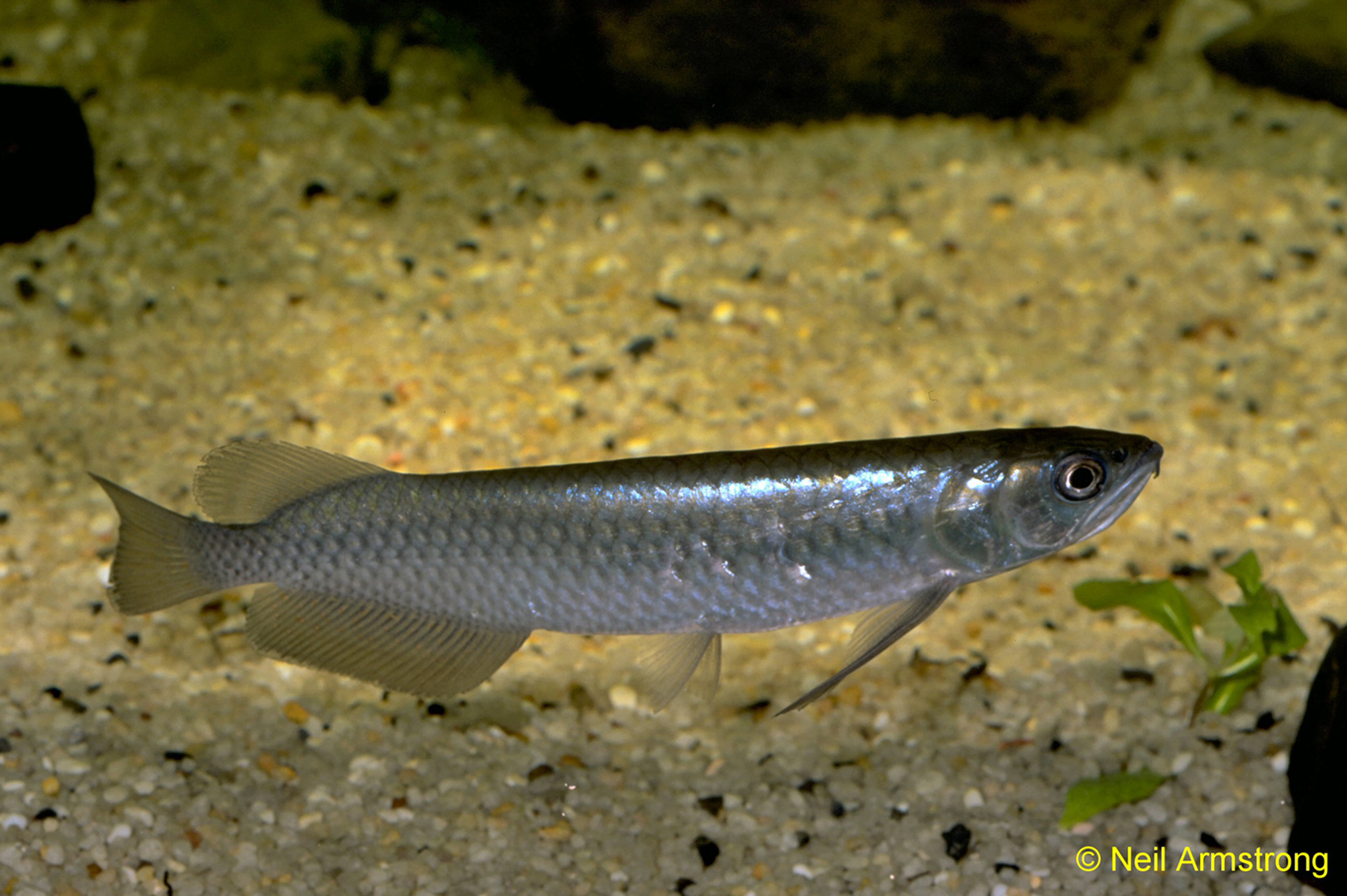Southern Saratoga, Scleropages leichardti Günther 1864

Southern Saratoga, Scleropages leichhardti. Source: Neil Armstrong. License: All rights reserved
Southern Saratoga, Scleropages leichardti Günther 1864
More Info
|
Distribution |
Endemic to the Fitzroy River system, QLD (23 30’S), and transplanted to other rivers of east QLD as far south as the Mary River (25 40’S). Inhabits still water billabongs or large pools and slow flowing sections of streams; usually in quite turbid conditions; often near the surface or near shore among aquatic vegetation. |
|
Features |
Dorsal fin 15-19; Anal fin 25-27; Lateral line scales 32-35. Body elongate and laterally compressed; dorsal profile of body and head straight; body moderately deep (24% of SL), slightly more so in females; head length less than one quater SL; mouth dorsally orientated, steeply sloping and extends back to rear margin of eye. Head scaleless; thick, bony scales with canals which form a mosaic-like pattern covering body. Soft dorsal placed posteriorly; pectorals pointed, reaching pelvic bases; anal fin underneath dorsal. |
|
Size |
Maximum TL about 100cm, commonly to 55cm. |
|
Colour |
Brown to olive overall with a silvery sheen and 1 or 2 orange to pinkish spots on most scales; median fins dark grey with a blackish edge and speckled with small pink spots. |
|
Feeding |
Opportunistic carnivore feeding on aquatic and terrestrial insects, small fishes and crustaceans. |
|
Biology |
Spawning by direct pairing after a prolonged courtship, generally from September to early November when daytime surface temperatures exceed 20-23°C. Females brood clutches of 30-180 eggs in the oral cavity. Eggs large (10 mm diameter). Hatch at 10-14 days, 15-36mm TL, and remain in the mothers’ oral cavity for another 4-5 weeks. First feeding at 2-3cm TL on micro-crustaceans, become independent of the mother at 3.5-4cm TL. |
|
Fisheries |
Renowned angling fish prized for its fighting ability and eating quality. Also traded in the aquarium industry. Territorial and aggressive towards other fishes, especially conspecifics. |
|
Remarks |
The species was originally described as leichardti and undoubtedly named after the explorer Leichhardt. Berra (1898) argued that the original spelling should be emended to leichhardti and some followed that suggestion (Paxton et al. 1989; Allen et al. 2006). However, the International Code of Zoological Nomenclature states that a misspelling must be apparent from the original description. It is clear from information not included in the publication that the fish was collected by Friedrich Wilhelm Ludwig Leichhardt. However, Günther indicated that the fish was collected by Dr Leichardt and used that spelling five times in the paper and used the same spelling subsequently (Günther 1868). A search of fish literature indicates that the spelling leichardti is far more common than leichhardti and consequently the subsequent spelling of leichhardti does not qualify to become the correct spelling under Article 33.3.1 of the International Code of Zoological Nomenclature (2000). |
|
Species Citation |
Scleropages leichhardti Gunther, 1864, Ann. Mag. Nat. Hist. (3)14(21): 195-197. Type locality: stated as the Burdekin River, QLD, but thought to be the Fitzroy River as the species is not native to the Burdekin River. |
|
Author |
Gomon, M.F. & Bray, D.J. 2016 |
|
Resources |
Southern Saratoga, Scleropages leichardti Günther 1864
References
Allen, G.R. 1989 Freshwater fishes of Australia. T.F.H. Publications, Inc., Neptune City, New Jersey.
Allen, G.R. & Boeseman, M. 1982. A collection of freshwater fishes from western New Guinea with descriptions of two new species (Gobiidae and Eleotridae). Records of the Western Australian Museum 10(2): 67-103 figs 1-7
Allen, G.R., Cross, N.J. & Hoese, D.F. 2006. Family Osteoglossidae. pp. 217-218 in Beesley, P.L. & Wells, A. (eds). Zoological Catalogue of Australia. Volume 35 Australia : ABRS & CSIRO Publishing Parts 1-3, 2178 pp.
Allen, G.R., Midgley, S.H. & Allen, M. 2002. Field Guide to the Freshwater Fishes of Australia. Perth : Western Australian Museum 394 pp.
Grant, E.M. 1975. Guide to Fishes. Brisbane : Queensland Government, Co-ordinator General’s Department 640 pp.
Grant, E.M. 2002. Guide to Fishes. Redcliffe : EM Grant Pty Ltd 880 pp.
Günther, A. 1864. On a new generic type of fishes discovered by the late Dr. Leichardt in Queensland. Annals and Magazine of Natural History 3 14(21): 195-197 pl. 7
Günther, A. 1868. Catalogue of the Fishes in the British Museum. Catalogue of the Physostomi, containing the families Heteropygii, Cyprinidae, Gonorhynchidae, Hyodontidae, Osteoglossidae, Clupeidae, [thru] Halosauridae, in the collection of the British Museum. London : British Museum Vol. 7 512 pp.
Lake, J.S. 1978. Australian Freshwater Fishes. Melbourne : Thomas Nelson 160 pp. 140 figs.
Leggett, R. & Merrick, J.R. 1987. Australian Native Fishes for Aquariums. Artarmon : J.R. Merrick Publications 241 pp. 142 figs.
Merrick, J.R. & G.E. Schmida. 1984. Australian freshwater fishes: biology and management. Griffin Press Ltd., South Australia. 409 pp.
Prokop, F. 2002. Australian Fish Guide. Croydon South, Victoria : Australian Fishing Network 256 pp.
Pusey, B.J., Fisher, C. & Maclain, J. 2016. On the nature of Scleropages leichardti Günther, 1864 (Pisces: Osteoglossidae). Zootaxa 4173(1): http://dx.doi.org/10.11646/zootaxa.4173.1.7
Pusey, B.J., Kennard, M.J. & Arthington, A.H. 2004. Freshwater Fishes of North-eastern Australia. Collingwood, Victoria : CSIRO Publishing 684 pp.
Wager, R. 1996. Scleropages leichardti. (errata version published in 2016) The IUCN Red List of Threatened Species 1996: e.T20035A95511020. Downloaded on 09 November 2016.



